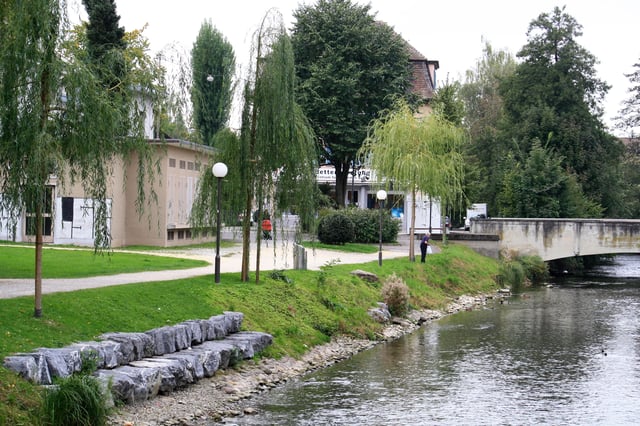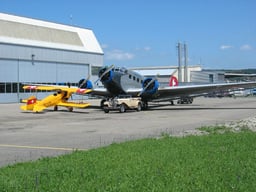Dübendorf

Dübendorf

Dübendorf | |
|---|---|
 | |
| Coordinates:47°25′N 8°37′E [18] | |
| Country | Switzerland |
| Canton | Zürich |
| District | Uster |
| Government | |
| • Executive | Stadtrat with 7 members |
| • Mayor | Stadtpräsident André Ingold (as of July 2018) |
| • Parliament | Gemeinderat with 40 members |
| Area | |
| • Total | 13.62 km2(5.26 sq mi) |
| Elevation | 440 m (1,440 ft) |
| Population (2018-12-31)[2] | |
| • Total | 28,667 |
| • Density | 2,100/km2(5,500/sq mi) |
| Postal code | 8600 |
| SFOS number | 0191 |
| Localities | Dübendorf, Dübelstein, Geeren, Gfenn, Gockhausen, Hermikon, Stettbach |
| Surrounded by | Dietlikon, Fällanden, Schwerzenbach, Volketswil, Wallisellen, Wangen-Brüttisellen, Zürich |
| Website | www.duebendorf.ch [19] SFSO statistics [20] |
Dübendorf is a fast growing municipality in the district of Uster in the canton of Zürich in Switzerland.
It is a suburb of Zürich in Switzerland with a population of about 28,000 (2018). It is the fourth largest city in the canton, after Zürich, Winterthur, and Uster.
Dübendorf | |
|---|---|
 | |
| Coordinates:47°25′N 8°37′E [18] | |
| Country | Switzerland |
| Canton | Zürich |
| District | Uster |
| Government | |
| • Executive | Stadtrat with 7 members |
| • Mayor | Stadtpräsident André Ingold (as of July 2018) |
| • Parliament | Gemeinderat with 40 members |
| Area | |
| • Total | 13.62 km2(5.26 sq mi) |
| Elevation | 440 m (1,440 ft) |
| Population (2018-12-31)[2] | |
| • Total | 28,667 |
| • Density | 2,100/km2(5,500/sq mi) |
| Postal code | 8600 |
| SFOS number | 0191 |
| Localities | Dübendorf, Dübelstein, Geeren, Gfenn, Gockhausen, Hermikon, Stettbach |
| Surrounded by | Dietlikon, Fällanden, Schwerzenbach, Volketswil, Wallisellen, Wangen-Brüttisellen, Zürich |
| Website | www.duebendorf.ch [19] SFSO statistics [20] |
History

Dübelstein castle, the so-called Waldmannsburg (1489)
Dübendorf is first mentioned in 946 as Tuobilindorf.[3] On the northeastern side of the Adlisberg the ruins of the Dübelstein castle are situated; from 1487 to 1489 the home of Hans Waldmann, former mayor of the city of Zürich.
Geography

Glatt river in Dübendorf
Dübendorf has an area of 13.6 km2 (5.3 sq mi). Of this area, 37.6% is used for agricultural purposes, while 19.5% is forested. Of the rest of the land, 41.9% is settled (buildings or roads) and the remainder (1%) is non-productive (rivers, glaciers or mountains).[4] In 1996 housing and buildings made up 29.6% of the total area, while transportation infrastructure made up the rest (12.3%).[5] Of the total unproductive area, water (streams and lakes) made up 1% of the area.
The city is situated roughly 10 km (6.2 mi) north east of Zürich. It is bisected by the Glatt river which runs from the Greifensee (Lake Greifen) which lies directly to the southeast. Dübendorf is located in the Glatt Valley (German: Glattal). Dübendorf is located on the northern side of the Adlisberg, as well, on a terrace on the northern side of the city of Zürich the hamlets Gockhausen and Geeren.
Demographics

Stadthaus, city administration and town hall
Dübendorf has a population (as of 31 December 2018) of 28,678.[6] As of 2007, 28.2% of the population was made up of foreign nationals. As of 2008 the gender distribution of the population was 49.2% male and 50.8% female. Over the last 10 years the population has grown at a rate of 10.5%. Most of the population (as of 2000) speaks German (81.8%), with Italian being second most common ( 4.5%) and Serbo-Croatian being third ( 2.1%).
In the 2007 election the most popular party was the SVP which received 39.1% of the vote. The next three most popular parties were the CSP (17.5%), the SPS (16.1%) and the FDP (10.4%).
The age distribution of the population (as of 2000) is children and teenagers (0–19 years old) make up 19.1% of the population, while adults (20–64 years old) make up 67.6% and seniors (over 64 years old) make up 13.3%. In Dübendorf about 73.6% of the population (between age 25-64) have completed either non-mandatory upper secondary education or additional higher education (either university or a Fachhochschule).[4] There are 10,786 households in Dübendorf.[5]
As of 2008 there were 7,733 Catholics and 7,553 Protestants in Dübendorf. In the 2000 census, religion was broken down into several smaller categories. From the census, 39.2% were some type of Protestant, with 37.1% belonging to the Swiss Reformed Church and 2.1% belonging to other Protestant churches. 33.6% of the population were Catholic. Of the rest of the population, 6% were Muslim, 9.4% belonged to another religion (not listed), 4.6% did not give a religion, and 12.4% were atheist or agnostic.[5]
The historical population is given in the following table:[3]
| Year | Population |
|---|---|
| 1467 | c. 225 |
| 1634 | 553 |
| 1710 | 1,031 |
| 1850 | 2,018 |
| 1900 | 2,544 |
| 1950 | 6,750 |
| 1970 | 19,639 |
| 2000 | 22,216 |
| 2010 | 24,607 |
| 2017 | 27,800 |
For more up-to-date population figures: http://www.duebendorf.ch/de/portrait/portraitfacts/factsbevoelkerung/ [21]
Industry

Helsana administration building in Stettbach quarter
Dübendorf is the home of two research institutions that are part of the Swiss Federal Institute of Technology domain (ETH-Bereich) [22] :
- EmpaEmpa is a materials science and technology research institution with 5 programs: Nanotechnology, Adaptive Materials Systems, The Healthy Human, Materials for Energy Technology and Technosphere - Atmosphere.EawagEawag is the Swiss Federal Institute of Aquatic Science and Technology. There are a variety of topics researched at Eawag: Applied Aquatic Ecology, Chemical Pollutants, Environmental Engineering, Environmental Microbiology, Environmental Toxicology, Fish Ecology and Evolution, Limnology, Surface Waters, Systems Analysis/Integrated Assessment and Modeling, Urban Water Management, Water and Agriculture, Water and Sanitation in Developing Countries (SANDEC), and Water Resources and Drinking Water.
Givaudan, producer of flavors and fragrances, has a part of its R&D department located in Dübendorf. Hewlett Packard's main Switzerland office is in Dübendorf.[7]
Dübendorf has an unemployment rate of 3.09%. As of 2005, there were 196 people employed in the primary economic sector and about 31 businesses involved in this sector. 2410 people are employed in the secondary sector and there are 234 businesses in this sector. 11663 people are employed in the tertiary sector, with 897 businesses in this sector.[4] As of 2007 76.1% of the working population were employed full-time, and 23.9% were employed part-time.[5]
Education
The Lycée Français Marie Curie de Zürich (LFZ), a French international school, is located on four campuses in the municipality.[11]
Places of interest

Obere Mühle, the cultural centre of Dübendorf
The town of Dübendorf is quite small and easy to get around on foot. Crossing from one side of the city to the other can be done within a half hour of casual walking. Apart the city center and the river, an interesting place to visit is the museum of military aviation [23] , displaying not just various military planes, but also various demonstration material (for instance, how helicopter control systems function) and two of the last original Junkers Ju 52 vintage aircraft in flying condition, which are used to provide sightseeing trips.
Transport
Dübendorf is served by both rail and bus links with the Zürich center (10 min), Winterthur (via Stettbach, 20 min) and other places in the canton of Zürich. Dübendorf railway station is a stop of the Zürich S-Bahn on the lines S9 and S14 and is a 13-minute (S9) ride from Zürich Hauptbahnhof. Stettbach railway station is a stop of the S-Bahn Zürich on the lines S3, S9 and S12.
The military airport hosts one of the Rega bases. It currently is no longer used as the base of military jets.






